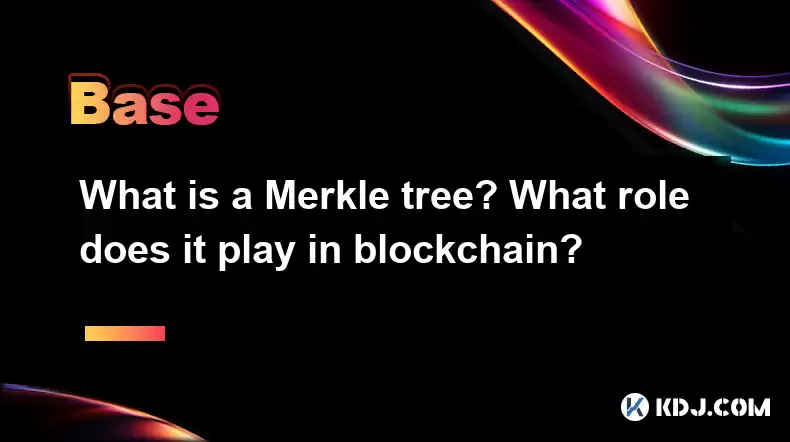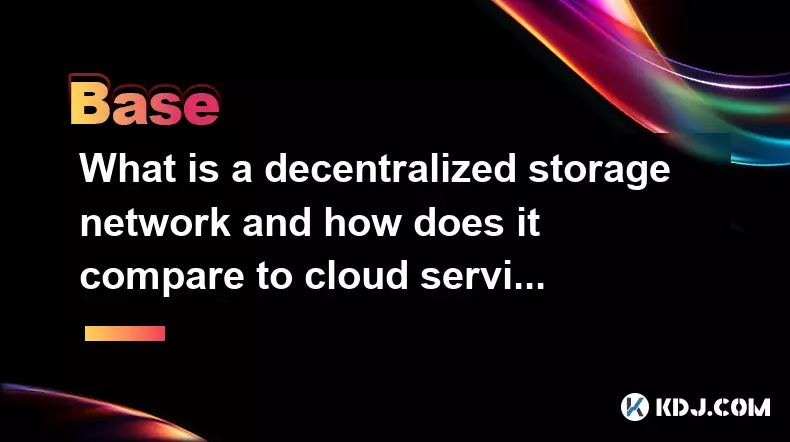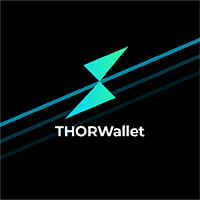-
 bitcoin
bitcoin $100977.009184 USD
-2.05% -
 ethereum
ethereum $3282.009150 USD
-3.23% -
 tether
tether $0.999813 USD
-0.02% -
 xrp
xrp $2.208254 USD
-4.89% -
 bnb
bnb $951.411089 USD
0.55% -
 solana
solana $155.761205 USD
-2.84% -
 usd-coin
usd-coin $1.000217 USD
0.02% -
 tron
tron $0.284475 USD
-1.28% -
 dogecoin
dogecoin $0.162363 USD
-1.53% -
 cardano
cardano $0.533988 USD
-0.47% -
 hyperliquid
hyperliquid $39.174339 USD
-3.22% -
 chainlink
chainlink $14.724828 USD
-1.16% -
 bitcoin-cash
bitcoin-cash $477.297986 USD
-1.28% -
 zcash
zcash $554.227426 USD
17.30% -
 ethena-usde
ethena-usde $0.998995 USD
-0.03%
What is a Merkle tree? What role does it play in blockchain?
Merkle trees ensure blockchain security and efficiency by allowing quick verification of transactions using Merkle proofs, enhancing scalability and integrity.
Apr 29, 2025 at 07:42 am

A Merkle tree, also known as a hash tree, is a data structure used to efficiently verify the integrity and consistency of large sets of data. In the context of blockchain, Merkle trees play a crucial role in ensuring the security and efficiency of the network. This article will explore what a Merkle tree is, how it works, and its specific role in blockchain technology.
Structure of a Merkle Tree
A Merkle tree is constructed by recursively hashing pairs of data blocks until a single hash, known as the Merkle root, is obtained. The process begins with the data at the leaf nodes, which are typically individual transactions in a blockchain.
- Each leaf node contains a hash of a data block.
- Pairs of leaf nodes are then hashed together to form the next level of the tree.
- This process continues, with each level being hashed until the top of the tree, where the Merkle root is formed.
The hierarchical nature of the Merkle tree allows for efficient verification of data integrity. If any single piece of data changes, the hash of that data changes, which propagates up the tree and results in a different Merkle root.
How a Merkle Tree Works
The efficiency of a Merkle tree lies in its ability to verify the inclusion of a specific piece of data within a large dataset using only a small portion of the data. This is achieved through what is known as a Merkle proof or Merkle path.
- To verify the inclusion of a leaf node, you need the hash values of the sibling nodes along the path from the leaf to the root.
- By hashing these sibling nodes with the hash of the leaf node in question, you can reconstruct the Merkle root.
- If the reconstructed Merkle root matches the known Merkle root of the entire dataset, the inclusion of the leaf node is verified.
This process is significantly more efficient than having to hash the entire dataset, especially for large datasets like those found in blockchain networks.
Merkle Trees in Blockchain
In blockchain technology, Merkle trees are used to efficiently summarize and verify the transactions within a block. Each block in a blockchain contains a list of transactions, and the Merkle tree is used to create a single hash that represents all the transactions in that block.
- The Merkle root of a block is included in the block header, which is then hashed to create the block's unique identifier.
- This allows nodes on the network to quickly verify the integrity of the entire block without needing to download and process all the transactions within it.
By using Merkle trees, blockchain networks can achieve a high level of scalability and efficiency. Nodes can verify the inclusion of transactions in a block by requesting a Merkle proof, which is much smaller than the entire block.
Merkle Trees and Simplified Payment Verification (SPV)
One of the most significant applications of Merkle trees in blockchain is in Simplified Payment Verification (SPV). SPV allows lightweight clients, often called 'light nodes,' to verify transactions without downloading the entire blockchain.
- Light nodes only need to store the block headers, which contain the Merkle roots of the transactions.
- To verify a transaction, a light node requests a Merkle proof from a full node.
- Using the Merkle proof, the light node can verify that the transaction is included in the block and that the block is part of the blockchain.
This makes SPV an essential tool for mobile wallets and other applications that require efficient transaction verification without the overhead of maintaining a full copy of the blockchain.
Merkle Trees and Data Integrity
Merkle trees are not only used for transaction verification but also for ensuring the integrity of the blockchain itself. Any alteration to a transaction within a block would result in a different Merkle root, which would invalidate the entire block.
- If a malicious actor attempts to alter a transaction, the Merkle root of the block would change.
- This change would be detected by nodes on the network, as the new Merkle root would not match the one stored in the block header.
- As a result, the altered block would be rejected, maintaining the integrity of the blockchain.
This mechanism provides a robust defense against tampering and ensures that the historical record of transactions remains accurate and unaltered.
Merkle Trees and Scalability
Merkle trees also contribute to the scalability of blockchain networks. By allowing nodes to verify the integrity of blocks using only the Merkle root and a Merkle proof, the network can handle a larger number of transactions without requiring each node to process the entire dataset.
- Nodes can quickly verify the integrity of a block by comparing the Merkle root in the block header with the one they calculate from the Merkle proof.
- This reduces the computational and storage requirements for nodes, enabling more nodes to participate in the network and increasing its overall capacity.
The use of Merkle trees thus plays a critical role in maintaining the balance between security, efficiency, and scalability in blockchain networks.
Frequently Asked Questions
Q: Can Merkle trees be used in other applications outside of blockchain?A: Yes, Merkle trees have applications beyond blockchain. They are used in peer-to-peer networks for file sharing, in distributed systems for data synchronization, and in cryptographic protocols for ensuring data integrity. Their ability to efficiently verify data integrity makes them valuable in any scenario where large datasets need to be managed and verified.
Q: How does the size of the Merkle tree affect its performance?A: The size of the Merkle tree directly impacts its performance. Larger trees, which represent more data, require more computational resources to construct and verify. However, the logarithmic nature of Merkle trees means that even for large datasets, the verification process remains relatively efficient. The depth of the tree, which is determined by the number of leaf nodes, dictates the length of the Merkle proof required for verification.
Q: Are there different types of Merkle trees used in blockchain?A: Yes, there are variations of Merkle trees used in blockchain technology. For example, Patricia Merkle Tries are used in Ethereum to efficiently store and retrieve key-value pairs. These structures combine the benefits of Merkle trees with trie data structures, allowing for faster lookups and more efficient state management in the Ethereum network.
Q: How do Merkle trees contribute to the security of a blockchain?A: Merkle trees enhance the security of a blockchain by providing a tamper-evident mechanism. Any alteration to a transaction within a block results in a different Merkle root, which would be detected by nodes on the network. This ensures that the historical record of transactions remains accurate and unaltered, maintaining the integrity and trustworthiness of the blockchain.
Disclaimer:info@kdj.com
The information provided is not trading advice. kdj.com does not assume any responsibility for any investments made based on the information provided in this article. Cryptocurrencies are highly volatile and it is highly recommended that you invest with caution after thorough research!
If you believe that the content used on this website infringes your copyright, please contact us immediately (info@kdj.com) and we will delete it promptly.
- BlockDAG, Avalanche, Dogecoin: Crypto's Leading Trio in 2025
- 2025-11-07 22:05:01
- Layer 2 Coins: Will There Be a Potential Explosion by 2026?
- 2025-11-07 16:50:02
- Filecoin, ICP, and the AI Infrastructure Renaissance: Is History Repeating?
- 2025-11-07 16:50:02
- Bitcoin's Wild Ride: Surges, Zeros, and the Search for Stability
- 2025-11-07 17:05:01
- XRP, Bitcoin, and the Rally: What's the Deal, New York?
- 2025-11-07 17:25:01
- Filecoin, DePIN, and a Technical Breakout: What's the Buzz?
- 2025-11-07 17:05:01
Related knowledge

How does a crypto insurance protocol work?
Nov 08,2025 at 12:39am
Understanding Crypto Insurance Protocols1. A crypto insurance protocol operates by offering financial protection against losses incurred from digital ...

What is a decentralized storage network and how does it compare to cloud services?
Nov 07,2025 at 11:59pm
Understanding Decentralized Storage Networks1. A decentralized storage network distributes data across a peer-to-peer infrastructure rather than relyi...

What is a factory contract and how is it used to deploy other contracts?
Nov 08,2025 at 04:20am
Understanding Factory Contracts in Blockchain Development1. A factory contract is a smart contract designed to create and deploy other smart contracts...

What is an address poisoning scam and how can you prevent it?
Nov 08,2025 at 02:20am
Understanding Address Poisoning Scams in the Crypto Space1. An address poisoning scam is a deceptive tactic used by malicious actors within the crypto...

What is liquid restaking and how does it build upon the concept of staking?
Nov 07,2025 at 06:19pm
Bitcoin’s Role in Decentralized Finance Evolution1. Bitcoin remains the cornerstone of decentralized finance, setting benchmarks for security and netw...

What is a concentrated liquidity position and how does it improve capital efficiency?
Nov 07,2025 at 06:00pm
Understanding Concentrated Liquidity Positions1. A concentrated liquidity position allows liquidity providers to allocate their capital within a speci...

How does a crypto insurance protocol work?
Nov 08,2025 at 12:39am
Understanding Crypto Insurance Protocols1. A crypto insurance protocol operates by offering financial protection against losses incurred from digital ...

What is a decentralized storage network and how does it compare to cloud services?
Nov 07,2025 at 11:59pm
Understanding Decentralized Storage Networks1. A decentralized storage network distributes data across a peer-to-peer infrastructure rather than relyi...

What is a factory contract and how is it used to deploy other contracts?
Nov 08,2025 at 04:20am
Understanding Factory Contracts in Blockchain Development1. A factory contract is a smart contract designed to create and deploy other smart contracts...

What is an address poisoning scam and how can you prevent it?
Nov 08,2025 at 02:20am
Understanding Address Poisoning Scams in the Crypto Space1. An address poisoning scam is a deceptive tactic used by malicious actors within the crypto...

What is liquid restaking and how does it build upon the concept of staking?
Nov 07,2025 at 06:19pm
Bitcoin’s Role in Decentralized Finance Evolution1. Bitcoin remains the cornerstone of decentralized finance, setting benchmarks for security and netw...

What is a concentrated liquidity position and how does it improve capital efficiency?
Nov 07,2025 at 06:00pm
Understanding Concentrated Liquidity Positions1. A concentrated liquidity position allows liquidity providers to allocate their capital within a speci...
See all articles





















![The Graph Price Prediction [GRT Crypto Price News Today] The Graph Price Prediction [GRT Crypto Price News Today]](/uploads/2025/11/07/cryptocurrencies-news/videos/690d4df44fe69_image_500_375.webp)




















































